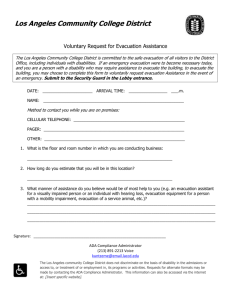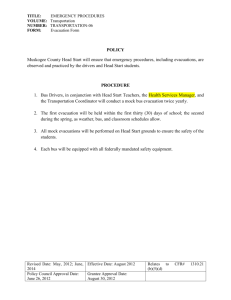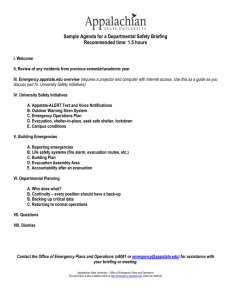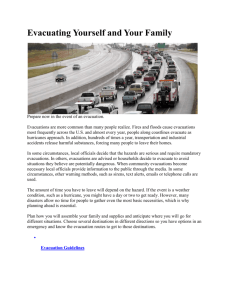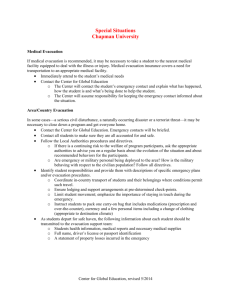Evacuation Template - Alaska Division of Homeland Security and
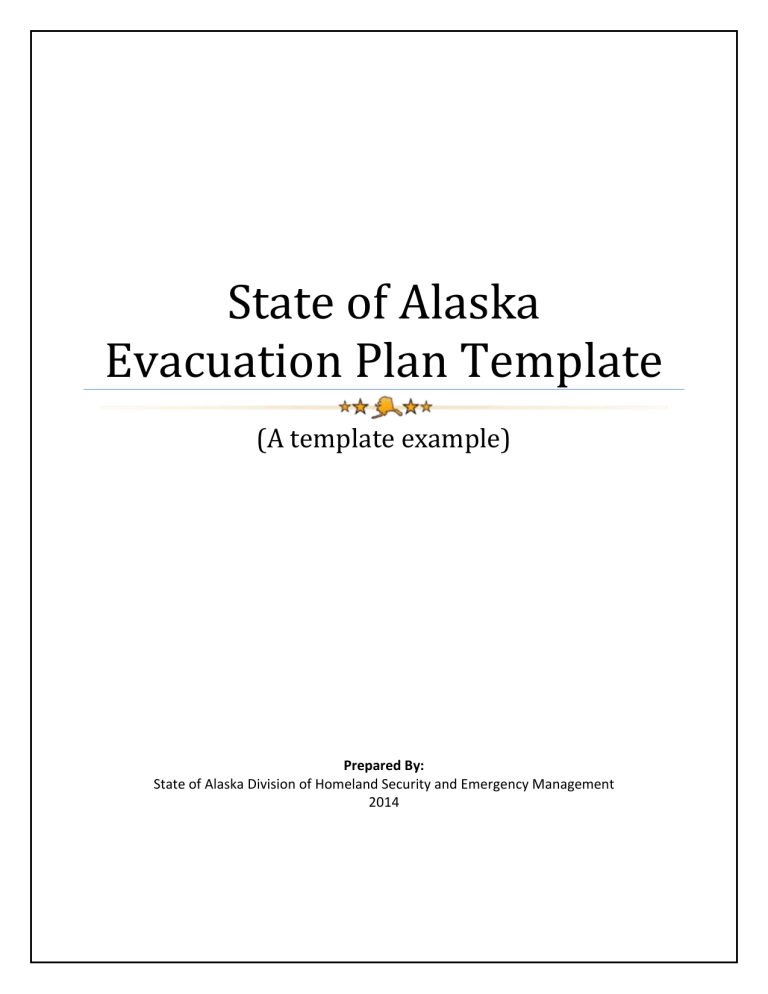
State of Alaska
Evacuation Plan Template
(A template example)
Prepared By:
State of Alaska Division of Homeland Security and Emergency Management
2014
Community Name Evacuation Plan 2014
Contents
(Date prepared) Page 2 of 33
Community Name Evacuation Plan 2014
Promulgation Letter
(Insert Text Here)
(Example)
The (Insert your Community) is faced with many hazards that are natural, technological and/or man-made that would require an area evacuation or call to shelter in place. This plan was written to assist the (Insert your Community) to provide for the orderly and expeditious evacuation of its populous from an area of risk to an area of safety.
This plan identifies local officials, leadership members and organizations that will manage the evacuation. It specifically describes processes and outlines potential resources to be utilized during an evacuation event. It is an all hazard plan that uses the NIMS Incident Command
System for comprehensive management.
This plan should be initiated when the impact of an incident requires community members to either shelter-in-place or evacuate to protect life and/or property.
The intent of this document is to be a living plan to be reviewed and revised on an annual basis to maintain its efficiency .
____________________________
Mayor Date
___________________________
City Manager Date
(Date prepared) Page 3 of 33
Community Name Evacuation Plan 2014
Record of Changes
The Evacuation Plan, including appendices, will be reviewed and approved on an annual basis.
All updates and revisions to the plan will be tracked and recorded in the following table. This process will ensure the most recent version of the plan is disseminated and implemented by emergency response personnel.
Change # Change Date Entered By Summary of Changes
(Date prepared) Page 4 of 33
Community Name Evacuation Plan 2014
Record of Distribution
This plan will be distributed to primary and secondary agencies.
Distribution
Number
Date Agency Signatory Official Agency
(Date prepared) Page 5 of 33
Community Name Evacuation Plan 2014
How to Use This Plan
This plan is a living document, written for the community, to be used in support of the
Community of
Community of
Emergency Operations Plan. The plan is intended to be utilized by the
officials and leadership as a tool in the event an evacuation becomes necessary.
If an imminent threat exists, consider immediately utilizing Part II and contact the Division of Homeland Security and Emergency
Management (DHS&EM) at 1-800-478-2337 as soon possible.
(Date prepared) Page 6 of 33
Community Name Evacuation Plan 2014
Introduction
There are essentially two types of life threatening events that require evacuation: one which allows time for a warning period and the other which occurs without warning. Considering both types of threats, there are two main protective measures for life safety: evacuation or shelterin-place. Evacuation is the process of removing people from a threatened or dangerous area to an area of safety. Evacuation is effective but is very complex and places high demand and stress on the populations. Sheltering-in-place is the practice of remaining in place during an emergency. This concept relies heavily upon a responsible, prepared population able to sustain itself independently until assistance arrives or the threat is removed.
Purpose
The intent of this plan is to provide for the orderly and expeditious movement of people to a safe area from an area believed to be at risk. Additionally, this plan describes the implementation of shelter-in-place procedures, if necessary .
Authority
Like most emergency events, evacuations will typically start at the local level and escalate as the impact, or anticipated impact, of the hazard spreads. Communities may choose to pass laws giving authority to implement an evacuation to a specific staff position such as a fire chief. The local community leads the planning and implementation of evacuations with support from the borough and state.
Local: Local officials with the registered Fire
Department have the authority to implement this plan in the community.
(Insert local laws if they exist)
Many communities have developed local laws that reflect who and how evacuations are implemented.
State: Alaska statues specifically give an official of a fire department registered with the State Fire Marshall’s office the authority to authorize an evacuation [AS 18.70.075 and .090].
While state and local law enforcement and various other emergency response organizations have no specific statutory authority to call for an evacuation they do have common law authority; common law refers to protecting the public from harm as part of normal job duties.
(Date prepared) Page 7 of 33
Community Name Evacuation Plan 2014
Situation
Describe your community’s threats, risks and hazards. Your local All Hazard Mitigation Plan is an excellent resource. There are many methods of depicting your community’s hazards or unique situation. Below is a short example of two versions: in text or in a chart.
(Insert Text Here)
(Example)
The (insert your community) is subject to a number of potential natural and technological hazards which might require the evacuation of segments or the entire the population. These include, but are not limited to: severe weather, coastal storm surge, erosion, flood and technological failure.
Event
Avalanche
Tsunami and Seiche
River Erosion
Earthquake
Flooding
Severe winter storm
Wildfire
Technological Failure
Ground Failure
Triggers for an Evacuation or Shelter in Place
High Risk
Probability of Occurrence
Medium Risk Low Risk
Unknown Risk
But Present
Note: Refer to Local All Hazard Mitigation Plan to fill out
No Risk
(Date prepared) Page 8 of 33
Community Name Evacuation Plan 2014
Assumptions
Insert the assumptions the community must make to allow this plan to be effective. See the example below. You may choose to use adjust, or delete these assumptions as appropriate.
It is assumed that:
In most instances there will be sufficient time available to warn the general public of an impending disaster and permit at least some evacuation effort.
Many evacuees will seek shelter with relatives and friends outside of the evacuated area without being mandated.
The (insert community) could be the recipient of evacuees from neighboring jurisdictions.
All memorandums of understanding/memorandums of agreement (MOU’s/MOA’s) needed for outside help are maintained and updated.
A large disaster in the vicinity may require evacuation of parts of the borough, as well as subsequent short term sheltering.
People who refuse to follow evacuation instructions will be advised of the associated risks and will be left alone until all who are willing to leave have evacuated. Time permitting, further efforts will be made to persuade those who haven’t evacuated to evacuate.
There will generally be a number of voluntary or spontaneous evacuees. Voluntary or spontaneous evacuees are those that leave their current location because of actual or perceived risk without being directed to do so. This could be categorized as a
“spontaneous” evacuation. The potentially negative consequences of people voluntarily or spontaneously evacuating can be minimized by effective public information management. Their movement, mode, and direction of travel are typically unorganized and unsupervised.
(Date prepared) Page 9 of 33
Community Name Evacuation Plan 2014
Limitations
Insert the limitations placed upon this plan, essentially the reality check. You may choose to use some of the examples below or adjust or delete them as appropriate.
(Insert Text)
(Example)
Severe weather conditions, darkness, or dangerous conditions could restrict movement of the population in general and prevent or hinder access to shelter sites.
The capacity of aircraft used for local evacuation is a limiting factor; the aircrafts may be owned by the community or borough yet not designed for mass evacuation.
The plan’s effectiveness is largely based on the partnerships and relationships developed before the need arises to have those working relationships.
Immediate threats such as a local tsunami will severely limit the ability of the community to provide assistance prior to the event.
(Date prepared) Page 10 of 33
Community Name Evacuation Plan 2014
Evacuation Terminology
The following terminology was generated through a group process involving state and local partners. It has been approved and accepted by the Division of Forestry as well as the Division of
Homeland Security and Emergency Management. It is suggested that these terms be adopted by the community to provide continuity across the state.
Evacuation Watch
This prepares the affected community or area for a possible threat and evacuation. It is not immediate but could be warranted within a specified time frame. This could be used under threat of a distant tsunami or with warning of an incoming storm. Individuals issued an
Evacuation Watch are not usually required to evacuate; however, doing so would be to their advantage.
Evacuation
This is implemented when there is an immediate threat and a suggested evacuation is imminent or immediate. Residents are advised to evacuate and not return until informed by emergency response personnel. Evacuations may be out of the community, but are usually from one threatened section of the community to a safer section. Evacuation orders may come with prior warning, but may also result from an immediate threat without warning. A no-notice evacuation happens when circumstances require immediate implementation of contingency plans. Examples include: hazardous materials release, tsunami, flash flood, or active shooter type events. This situation can pose significant disadvantages, as a no-notice evacuation can congest transport corridors and cause panic if not managed properly.
Phased Evacuation
Planning for a zone-by-zone evacuation may be a viable solution to logistic problems encountered with large scale evacuations or when evacuations are caused by escalating hazard risks. Area specific evacuations may be decided by topography or may be based on geographically determined suburbs. This will depend on the nature of the hazard. Phased evacuations require extensive pre-planning, operational coordination, and public information management strategies.
(Date prepared) Page 11 of 33
Community Name Evacuation Plan 2014
Mandatory Evacuation
A mandatory evacuation is ordered when the risk to residents is too great to allow them to remain in place. Mandatory evacuations place a great burden on emergency service resources and a duty of responsibility on authorities to ensure care for people who are evacuated.
In Alaska, the authority for ordering a mandatory evacuation rests only with the Governor or an official of a fire department registered with the Alaska
Fire Marshall’s office [AS 18.70.075 and .090]. Local governments may decide to create a local ordinance to authorize the implementation of evacuations by people other than fire department officials. Mandatory evacuations or evacuations by force are not widely supported in Alaska and should only be discussed in the case of unaccompanied minors, people under the
Local governments may decide to create a local ordinance to authorize the implementation of evacuations, mandatory or otherwise, by people other than fire department officials. influence of drugs or alcohol, or people unable to make sound decisions due to mental illness or other special considerations.
(Date prepared) Page 12 of 33
Concept of Operations
Community Name Evacuation Plan 2014
This section provides for an operational framework that outlines how an evacuation would be initiated and managed from the onset to the return. The examples below are very basic and should be used a guide to lead the discussion and development of the plan.
(Insert text here)
(Example)
A.
Most outside agency advanced notifications of potential threats requiring evacuation will come into and be routed through the Police and Fire Dispatch Center.
B.
Dispatch shall notify the Police Chief and Fire Chief (through normal chain of command), the Emergency Programs Manager, and the City Manager (if Emergency Programs
Manager unavailable)
C.
An evacuation may be initiated by any of the follow:
Mayor
City Manger
Police Chief
Fire Chief
Emergency Operation Center
VPSO, Senior Law Enforcement, Health Officer at the scene
Check the local ordinance to determine who can order an evacuation.
D.
Upon recognition that an emergency event is probable, the community will utilize local personnel to model the Incident Command Structure (ICS) to form an Incident
Management Team (IMT). The IMT will be briefed of the situation and potential threat.
This team can scale in size to meet the needs of the emergency by filling those positions that are necessary to handle the incident .
E.
Generally speaking, there are two types of evacuations: area-to-area evacuation and mass evacuation. Most threats would require an area-to-area evacuation rather than a large scale mass evacuation. Factors such as magnitude, intensity, spread of onset, and duration of the emergency will determine the type of evacuation required. Area-to-area evacuations might be required for small-scale localized incidents such as a hazardous
(Date prepared) Page 13 of 33
Community Name Evacuation Plan 2014 materials accident, major fire, avalanche, transportation accident, or flooding. Mass evacuations may be necessary for extreme acts of terrorism or major natural disaster.
F.
Area-to-area evacuations will be initially managed on-scene by the Fire or Police
Department.
G.
During an emergency requiring immediate evacuation, all residents needing evacuation transportation assistance will be given equal priority. Following an evacuation event where the immediate danger has passed, vulnerable populations will be given priority for evacuation.
H.
Once an authorized official has ordered an evacuation, the Insert Community will make every effort to evacuate all persons from the designated area. Any person who refuses to evacuate will be advised by emergency personnel of the associated risks and will be asked their next of kin and to sign a liability release document, if practicable.
I.
Once the Emergency Operations Center (EOC) and the IMT have been activated all public information will be coordinated through the EOC or Incident Commander (IC) and will be broadcast over the Emergency Alert System (EAS) and through the news media.
Other forms of evacuation warnings may include: door-to-door notification, mobile sirens, public address systems, and distribution of pamphlets.
J.
Protection of human life is the primary goal of emergency responders. During a disaster emergency, fire and police personnel are not responsible for the rescue, evacuation, sheltering, or welfare of animals. It is highly recommended that animal owners develop individual evacuation plans for their pets and livestock.
K.
Each individual or head of household within the Insert Community is encouraged to develop a family disaster plan that includes maintaining the essential supplies to sustain them for at least seven days.
L.
Businesses and private educational institutions should establish evacuation plans and be familiar with Insert Community evacuation directives as part of their emergency procedures.
M.
Child and adult care facilities are required to establish evacuation plans, which are to be included in their all-hazards emergency plan and on file.
N.
A public information officer will be dispatched to assembly areas.
(Date prepared) Page 14 of 33
Community Name Evacuation Plan 2014
O.
Public transportation and school buses may be used to provide transportation to designated assembly areas or shelters.
P.
Insert the Regional Hospital or Health Clinic will provide medical care and support mass care operations. Coordinate to ensure the medical facility has up-to-date emergency procedures.
Q.
During an area-to-area evacuation, public schools will evacuate students to appropriate schools designated as shelters in a less affected area, if it is deemed safer than sheltering in place.
R.
The IMT will determine some way to account and track
Tracking evacuees could be as simple as pen and paper lists.
S.
When the hazard is mitigated and it is safe to return, the IC will coordinate the return with the Police, Fire, Village Public Safety Officer (VPSO), Troopers, etc. the evacuees being moved by the team.
(Date prepared) Page 15 of 33
Community Name Evacuation Plan 2014
Responsibilities
(Insert Text)
Ensure that these responsibilities are accurate for your community, making changes as necessary.
Also ensure the relationships between stakeholders have been established to allow these duties to be performed. Add and delete any partners in your community. This example provides suggestions of who could be involved and how.
(Example)
Primary Agencies
Police Department/VPSO
1.
Direct initial on-scene evacuation and coordinates overall incident response.
2.
Assist with dissemination of evacuation instructions and information to the public.
3.
Provide damage assessment to the EOC regarding the viability of evacuation routes.
4.
Manage traffic and crowd control for evacuations.
5.
Manage access to and protects property within evacuated areas and shelters.
6.
Coordinate removal of stalled vehicles and equipment from evacuation routes.
7.
Assist in notifying the EOC regarding location and welfare of affected citizens.
3.
4.
5.
Fire Department
1.
2.
Order evacuations whenever necessary to protect lives and property.
Direct initial on-scene evacuation and coordinates overall incident response through
EOC, once it is activated.
Assist with dissemination of evacuation instructions and information to the public.
Provide damage assessment to the EOC regarding the viability of evacuation routes.
Perform normal emergency lifesaving functions.
(Date prepared) Page 16 of 33
Community Name Evacuation Plan 2014
4.
5.
6.
1.
2.
3.
Emergency Operations Center/Incident Management Team
Coordinate overall strategic disaster response during a major emergency or disaster.
Secure additional resources through state and federal agencies as needed.
Coordinate with and support requests from field agencies during a major emergency or disaster.
7.
8.
9.
Determine assembly points in evacuation zones.
Assume strategic long-term planning for mass evacuations.
Disseminate emergency evacuation information to the public and deploy public information officers to evacuation assembly areas.
Order evacuations whenever necessary to protect lives and property.
Coordinate the identification and establishment of evacuation routes, detour routes, and road closures and ensure coordination of evacuation routes with neighboring jurisdictions.
Coordinate reentry with the police and fire departments when the conditions that caused the mandatory evacuation cease to exist or have dramatically reduced.
Public Transportation
1.
Coordinate mass transit requirements to support evacuation efforts.
2.
Ensure that evacuation transportation is available to persons with disabilities.
Health Clinic/Hospital
1.
Perform at an emergency status, triaging patients as needed due to the emergency.
2.
Follow normal organizational Standard Operating Procedures (SOP’s) and emergency operation plans.
Office of the Mayor/ City Manager’s Office/Local Government
1.
Ensure the public is informed by an elected official and the information is consistent with the information released from the EOC.
(Date prepared) Page 17 of 33
Community Name Evacuation Plan 2014
Support Agencies
Public Works
1.
Install traffic control signs and barricades and direct the operational control of traffic signals and flashers.
2.
Assist with the identification of evacuation routes.
3.
Assist with damage assessment including roadway and bridge safety assessment.
4.
Provide liaison to EOC as necessary, keep EOC updated on current situation regarding evacuation routes.
State Department of Transportation
1.
Coordinate with EOC to determine evacuation roadways.
2.
Ensure evacuation routes are operable and assist with signage identifying evacuation routes.
American Red Cross of Alaska
1.
Coordinate with the EOC to support sheltering operations.
2.
Support mass care efforts and disaster assistance.
3.
Utilize the web based registry Safe and Well for accountability.
Salvation Army
1.
Coordinate with the EOC to assist with mass care efforts.
School District
1.
Coordinate movement of students to safety and report location to EOC.
2.
Contact parents or guardians of evacuated students to advise them of their location.
3.
Augment municipal evacuation activities when school is not in session or after ensuring the safety and evacuation of students such as providing buses.
4.
Coordinate with the EOC, providing information on the schools functioning as shelters if necessary.
Volunteer Search and Rescue
1.
Assist the Police and Fire Department with the evacuation of persons from an area of
2.
risk.
Assist the hospital/village clinic with triage.
(Date prepared) Page 18 of 33
Community Name Evacuation Plan 2014
Evacuation Operations
Generally, this section can be left as is, but changes relevant to the community should be made as needed.
All evacuations move through five distinct phases, no matter the hazard. The demands on emergency managers and resources change as the evacuation progresses through each phase.
Evacuation plans should consider all phases.
Decision (to implement an evacuation)
Notification of officials and public
Evacuation
Shelter
Return
The diagram below shows the evacuation phases, including shelter in place and voluntary evacuations:
Hazard
Threat /
Impact
DECISION
Situational
Awareness
Hazard
Assessment
Hazard Control
Decision Point
Evaluate
Choose
Course of Action
NOTIFICATION
Disseminate
Notification
Message
Voluntary or Spontaneous Evacuation
EVACUATION
Shelter in Place
SHELTER
Temporary
Shelter
Long-Term
Recovery
Center
Temporary
Housing
RETURN
“All-Clear”
Return
Home
(Date prepared) Page 19 of 33
Community Name Evacuation Plan 2014
Decision
The decision phase constitutes the period when intelligence from the field is measured and a choice is made whether to order an evacuation or advise people to shelter-in-place. Evacuation plans should clearly state who in the community is authorized to make such decisions. Include some redundancy to account for designees being out of the community or unable to make the decision due to an effect of the event.
The decision making process should include the following sequence:
Situational Awareness
Hazard Assessment
Hazard Control
Decision Point
Evaluate
Notification
The notification phase occurs after a decision has been made. Notifications are issued to the public advising them of the situation and what action they should take. This notification can be made via radio, siren, phone tree, door-to-door, or by any other means effective for the community and situation.
Evacuation
The evacuation phase describes the actual physical movement of people from a building, area, or zone under threat to a safe area. Every effort should be made to assist with transportation and logistics, including managing traffic. Trained staff or volunteers should be used to help direct traffic and avoid congestion as much as possible.
Evacuee Collection Point
Evacuations may require the use of evacuee collection points, which allow for the registration and accountability of evacuees prior to sheltering or movement to safe locations.
Temporary Re-entry
Incident Commanders (IC) or local officials may choose to allow residents to return to their property on a temporary basis for essential items or to assess activities. A timeframe should be established such as a 2, 4, or 6 hour re-entry time. This should be coordinated between the local officials and the residents.
(Date prepared) Page 20 of 33
Community Name Evacuation Plan 2014
Shelter
The shelter phase of an evacuation involves designating a location for evacuees to wait, out of the elements, until it is safe for them to return home. Depending on the event, this shelter phase could continue for several days. Long term shelter operations or temporary housing are aspects of recovery and do not need to be addressed in evacuation planning. Accommodation should to be made for all residents and detailed records kept of who is staying in the shelter overnight and who is physically present at any given time to maintain accountability.
Return
The return phase involves assessing the area for further hazards, informing the evacuees and public, coordinating their return, and transitioning to the recovery phase of operations. Return should only occur when the threat is no longer imminent and residents have full access to the area.
(Date prepared) Page 21 of 33
Community Name Evacuation Plan 2014
Message Delivery
The insert community has multiple means of delivering the evacuation watch or warning,
Examples below should be removed and reflect what the community has to offer. Here the community should also identify who (generally an elected official) should present this information to the public.
Including but not limited to:
EAS o Primary source is KINY–AM 800, Location: 1107 E 8 th St., Phone: 907-586-1800 o Secondary source: KTOO-FM 104.3, Location: 360 Egan Dr., Phone: 907-586-
1670 o Tertiary source: NOAA Weather Radio 162.400 MHz, Location: 8500 Mendenhall
Loop, Phone: 907-790-6803
Sirens: Tsunami, Salmon Creek Dam Failure
Public Announcement Systems o Police Department o Fire Department o City Streets?
Door to door o PD, Fire Department
Cable TV and Radio
City email
State email
National Weather Service’s NOAA weather radio system
Facebook Page
Twitter and Facebook Page
(Date prepared) Page 22 of 33
Community Name Evacuation Plan 2014
Evacuation Phase
This phase involves the actual movement of people away from the threat by any means necessary. This is the most complex aspect of evacuation planning; however, maintaining a highly organized EOC, an educated public, and well established pre-disaster relationships will help mitigate potential problems.
Ensure this broad framework will work for your community or make adjustments. Utilize stakeholders to shape this framework and gain buy-in. Address the highlighted area below to help establish the framework.
Broad Framework:
Identify who will: Establish a perimeter around the impacted or to be impacted area
Identify who will: Establish evacuation routes and perform traffic control
Individuals refusing to evacuate will be informed of associated risks and asked to sign a waiver
Identify who will: Assist in transporting vulnerable population
Evacuees will be directed to an assembly area or to emergency medical attention
Evacuees will be transported from the assembly area to the shelter
Consider Geographic Division (Evacuation Zones)
Organization is imperative to efficiently move evacuees. Consider dividing your community into sections. Within the sections identify shelters and evacuation routes. Consider possibly using school districts or fire districts to accommodate this division. People will generally be most comfortable in the area closest to their residence.
(Include a map of your community with evacuation routes marked – this can be an annex)
(Date prepared) Page 23 of 33
Community Name Evacuation Plan 2014
Evacuation Movement
Provide a framework on how the movement of evacuees will be managed. See example below:
The EOC will designate assembly points where those within an evacuation zone will congregate to be transported to the shelter.
By establishing assembly points officials can: o Regulate flows to shelter centers o Register evacuees o Start accountability o Gather information and begin to assess damage o Determine needs for medical care, transportation, and sheltering
Police will manage evacuation routes o Consider traffic control points to begin accounting for large numbers of individuals evacuated from the area and control traffic flow
Public works will provide signage for evacuation routes and road closures
Public transportation will assist with the movement of people focusing on special needs populations
Evacuation of Animals
The Insert community highly encourages pet/livestock owners to develop a plan for their animals.
The insert community prioritizes saving human life.
The insert community also realizes the value placed on our animals. The EOC will attempt to incorporate strategies to safely evacuate and shelter animals.
Owners are responsible for ensuring the safety of their animals.
(Date prepared) Page 24 of 33
Community Name Evacuation Plan 2014
Vulnerable Population Considerations
Work with local organizations and medical facilities to stay aware of the types of vulnerable populations in the community. This can include the homeless, elderly, people with functional support needs, orphans or foster children, people with limited English, and tourists or seasonal workers. Below are things to take into account when planning.
Understanding of the numbers and locations of those at particular risk has a number of benefits. This information aids in the generation of an evacuation plan customized to the needs of the whole community and leads to better decision making during an event. The process of finding this information will engage local leaders and community groups with wider elements of the community, promoting overall readiness. In doing so, local leaders may be able to develop specific plans for the community to incorporate into the overall evacuation plan.
Consider a voluntary registry to locate people who may need assistance evacuating.
The insert community recognizes its vulnerable populations. The insert community commits to work with appropriate groups to identify vulnerable populations and determine the most efficient method of expeditious evacuation, with respect to the limitations of the incident.
Following an evacuation event where the immediate danger has passed (earthquake), vulnerable populations will be given priority for evacuation transportation otherwise equal support will be given.
Vulnerable populations are depicted by the following:
1)
2)
3)
Warning
Ability to receive and/or recognize the notification message
Ability to identify a response
Ability to perform the correct response in a reasonable time
Detail any mechanisms within the community to notify people with hearing or visual impairments or other difficulties receiving broadcasts.
(Date prepared) Page 25 of 33
Community Name Evacuation Plan 2014
Transportation
Describe any specific mechanism/asset the community has to transport functional needs populous and outline a framework.
Relevant Coordinating Agencies
1.
EOC
2.
Local special needs advocacy groups
3.
Elder care facilities
4.
Medical facility
(Date prepared) Page 26 of 33
Community Name Evacuation Plan 2014
Temporary Re-entry and Return Phase
The temporary re-entry phase gives the IC an opportunity to allow residents to return to their property on a temporary basis. Generally the return is allowed for essential items or to assess the status of the area. A timeframe will be established such 2, 4, or 6 hours for re-entry.
A return differs from a temporary re-entry in that in a return means that the threat is no longer imminent and residents have full access to the area. This decision is made through the IC at the
EOC.
Temporary re-entry:
Identify who will issue a specific and informative message to the public o What to expect o Length of re-entry o What identification is necessary
EOC/ IMT will coordinate with first responders to ensure perimeter control
EOC/ IMT will coordinate with law enforcement officers for access control (entry and exit)
Return:
An assessment of the evacuated area o Engineers may be needed to provide technical assistance
Identify who will issue an all-clear o Inform public of what to expect o Inform public of precautionary measures
Identify who will coordinate the physical return of evacuees
Identify who will continue to supply recovery provisions to affected families
(Date prepared) Page 27 of 33
Community Name Evacuation Plan 2014
Community Data
This section is designed to capture pertinent data that could be utilized as a quick reference by the Emergency Operation Center. See the examples below.
Description (Approximate) Total
Adult (65 and older)
Adult (18 - 65)
Youth (4-17)
Toddler (0-4)
Population
Functional Needs
Ex. Geriatric folks, home bound elders, dialysis patients
TOTAL (approximate)
(Consider utilizing the appropriate agency to obtain information about the functional needs population and considerations that should be taken into account during an evacuation)
Transportation
Transportation Type Quantity Capacity Owner Contact #
Aircraft
(Consider MOA/MOU)
Public Transit
School Buses
Other
Length Width
Public Runway Data
Surface Latitude
This section should be customized to reflect the best information for your community’s EOC during an evacuation event.
Longitude
(Date prepared) Page 28 of 33
Type
Primary Shelter
Secondary Shelter
Pet Shelter
Community Name Evacuation Plan 2014
Shelters
Location Reg. Capacity Contact
Communication Type
Communication
Channel Owner/Contact Information
Refer to State of Alaska Tactical Interoperable Communications Plan (TICP) for further details
Description
Locally Owned Resources
Owner Contact
(Date prepared) Page 29 of 33
Community Name Evacuation Plan 2014
Organization, Roles and Responsibilities
This section is designed to identify who has what roles and responsibilities during and evacuation.
There are a number of ways to format this information. Below is a chart example and an example in text format.
Here is an example of using a chart to capture the roles and responsibilities.
P = Primary Functional
Responsibility
S = Support
Responsibility −
Entities have potential functions, but may not be activated for all incidents
Office of the Mayor
Village/Tribal Gov’t
City Manager
Volunteer Search and
Rescue
Fire Department
Police Department
A chart like this should be used within a community that has well defined standard operating procedures within its departments.
This chart can also be used as
a quick
reference.
(Date prepared) Page 30 of 33
Community Name Evacuation Plan 2014
Appendix A Organizational Chart
This section is designed to provide a visual chart of the Incident Command Structure. Below are two different examples of Incident Command Structures.
This is a nontraditional ICS chart but may be beneficial for smaller communities with less infrastructure.
Incident
Commander (IC)
Mayor, Fire Chief
Public Information
Specialist
Vice Mayor, Tribal Coor .
Incident Liaison
Vice Mayor, IGAP
Coordinator
Evacuation
Specialist
Fire Chief
(Date prepared)
Medical Specialist
Practitioner/ Health Aid
Security Specilist
VPSO
Shelter Specialist
School Principal
Page 31 of 33
Community Name Evacuation Plan 2014
This is a traditional ICS chart that may be appropriate for larger cities with lots of infrastructure.
The ICS structure can always be expanded or contracted as the event requires.
Incident
Commander
(IC)
Public Information
Incident Liaison
Safety Officer
Operations Planning Logistics Finance
Evac Branch Security Branch Shelter Branch Medical Branch
(Date prepared) Page 32 of 33
Community Name Evacuation Plan 2014
Appendix B General Checklist
PLANNING:
1. Determine evacuation area(s) at risk:
Use readily identifiable boundaries
Determine population of risk area(s)
Identify any special needs facilities and populations in risk area(s)
2. Determine evacuation routes for risk area(s) & check the status of these routes.
3. Estimate public transportation requirements & determine pickup points.
4. Determine temporary shelter requirements. ** Identify number of people.
EVACUATION WATCH:
5. Provide advance warning to special needs facilities and advise them to activate evacuation, transportation & reception arrangements.
6. Coordinate with special needs facilities regarding precautionary evacuation. Identify and alert special needs populations.
7. Ready temporary shelters for use.
8. Coordinate with transportation providers to ensure vehicles & drivers will be available when and where needed.
9. Coordinate with school districts regarding closure of schools.
10. Advise neighboring jurisdictions if evacuation to their community is expected.
EVACUATION:
Assigned
11. Advise neighboring jurisdictions of evacuation status** Identify number of people to be evacuated .**
12. Disseminate evacuation notice to the public with special attention given to notifying special need facilities and populations.
13. Provide additional information to the public through the media. Emergency public information should address:
What should be done to secure buildings being evacuated
What evacuees should take with them
Where evacuees should go and how they should get there
Provisions for special needs population and those without transportation
14. Staff and open temporary shelters.
Track all individuals (families) placed in the local shelter.
Track all individuals leaving the community.
15. Provide situation reports on evacuation to the borough and SEOC
PRIOR TO THE RETURN OF EVACUEES:
16. If evacuated areas have been damaged, reopen roads, eliminate significant health and safety hazards, and conduct damage assessments.
17. Determine requirements and coordinate provision for evacuee return transportation.
18. Advise neighboring jurisdictions and SEOC that return of evacuees will begin.
RETURN OF EVACUEES:
19. Advise evacuees through the media that they can return to their homes.
20. Coordinate with special needs facilities to return those evacuees back.
21. If evacuated areas have sustained damage, provide the public information that addresses:
Documenting damage and making expedient repairs
Caution in reactivating utilities and damaged appliances
Cleanup and removal/disposal of debris
Ongoing safety concerns
22. Terminate temporary shelter and mass care operations.
23. Maintain control for areas that cannot be safely reoccupied.
(Date prepared) Page 33 of 33



